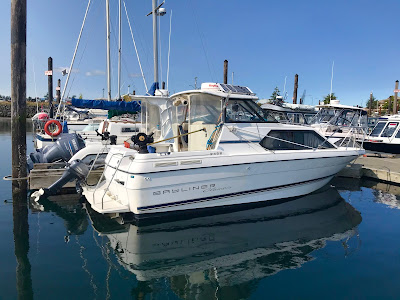Come to Powell Lake for Fall Foliage
 |
| Leaves turning on Goat Island. |
In front of our cabin, Goat Island has a glorious display of maples, dogwoods and alders. The swaths of colour paint the hillsides along stream carved gullies and slopes.

Have you wondered how this colourful display occurs? Chlorophyll, the pigment that gives leaves their green colour, gets energy from sunlight to transform carbon dioxide and water into carbohydrates (sugars and starch). Leaves also have yellow to orange pigments called carotene and xanthophyll, but they are overpowered by chlorophyll most of the year. When fall arrives, things change.
 Days are shorter and deciduous trees, ones that lose their leaves, get ready for winter. Chlorophyll, and its green colour, begins to diminish. This allows the yellow and orange colours to become more dominant.
Days are shorter and deciduous trees, ones that lose their leaves, get ready for winter. Chlorophyll, and its green colour, begins to diminish. This allows the yellow and orange colours to become more dominant.Reds and purples are created when glucose (sugars) are trapped in leaves after photosynthesis stops. Bright sunny days and cool nights in autumn cause leaves to turn the glucose into red to purple colours. A brown colour is from wastes left behind in the leaves.

As winter approaches, leaves begin to fall. Where the stem of a leaf is attached to the tree there is a special layer of cells. This layer gradually breaks down until it can no longer support the weight of the leaf. When storm winds blow, leaves drop. Trees become dormant and live off the food they have stored over the summer. Their stems, twigs and buds are equipped to survive extreme cold until the following spring.
Fallen leaves are not wasted. They become part of the thick humus layer of the forest floor and decay to replenish the soil with nutrients. There also absorb rainfall, hold moisture and become food for organisms that are important to the forest ecosystem.
Here are some resources if you would like more details:
- SUNY College of Environmental Science and Forestry
- Science Made Simple
- U.S. Department of Agriculture (pdf)
 Next year when travel is safer, come to Powell River in Coastal BC to experience fall foliage. People here are friendly, the resorts are uncrowded and the restaurants are great. The opportunities are limitless. You won’t be sorry you chose to head north rather than east. -- Margy
Next year when travel is safer, come to Powell River in Coastal BC to experience fall foliage. People here are friendly, the resorts are uncrowded and the restaurants are great. The opportunities are limitless. You won’t be sorry you chose to head north rather than east. -- Margy 
































